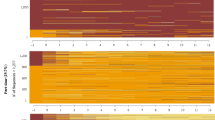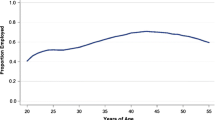Abstract
It has been suggested that work-motivated women may shorten their birth intervals to allow a faster return to the workforce. This paper: (i) considers the circumstances under which such contraction would be expected; (ii) argues that British conditions in the 1940s to 1970s were favourable to the adoption of this strategy, among others; (iii) discusses some methodological issues arising in the empirical treatment of the question; and (iv) presents the results of analyses of work and maternity history information, which suggest that during the post-war period, labour-force participation was associated with both a contraction and a lengthening of birth intervals.
Résumé
On a dit que les femmes intéressées par le travail salarié pouvaient raccourcir leurs intervalles entre naissances pour reprendre plus vite leur activité. Cet article évalue les conditions d'une telle contraction, montre que le climat de la période des années 40 aux années 70 en Grande-Bretagne était favorable à cette stratégie, et étudie quelques problèmes méthodologiques soulevés par le traitement empirique de cette question. Il présente aussi les résultats de diverses analyses de données longitudinales sur l'activité économique et la maternité, qui indiquent que, pendant la période d'après-guerre, l'activité économique des femmes a été associée à des contractions aussi bien qu'à des allongements des intervalles intergénésiques.
Similar content being viewed by others
References
Atkins, E., N. Cherry, J.W.B. Douglas, K.E. Kiernan and M.E.J. Wadsworth, 1981, The 1946 British birth cohort: An account of the origins, progress, and results of the National Survey of Health and Development, in: S.A. Mednick and A.E. Baert, eds., Prospective longitudinal research (Oxford University Press, Oxford) 25–30.
Brass, W., 1981, Estimating fertility from birth order data, Seminar presented at the Centre for Population Studies, Dec. 1981.
Brass, W., 1982, Pace and parity in fertility: Italy contrasted with England and Wales, Seminar presented at the London School of Economics, Nov. 1982.
Britton, M., 1979, Birth intervals, Population Trends 18, 8–16.
Britton, M., 1980, Recent trends in births, Population Trends 20, 4–8.
Britton, M. and C.M. Langford, 1976, Work since marriage, in: C.M. Langford, Birth control practice and marital fertility in Great Britain (PIC, London) ch. 8.
Bumpass, L.L. and J.A. Sweet, 1980, Patterns of employment before and after childbirth, Vital and Health Statistics, Series 23, no. 4 (US National Centre for Health Statistics, Hyattsville, MD).
Carliner, G., C. Robinson and N. Tomes, 1984, Lifetime models of female labour supply, wage rates, and fertility, Research in Population Economics 5, 1–27.
Cigno, A., 1983, Human capital and the time-profile of human fertility, Economics Letters 13, 385–392.
Collomb, P. and E. Zucker, 1977, Aspects culturels et socio-psychologiques de la fécondité française, Travaux et Documents, Cahier no. 80 (INED, Paris).
De Cooman, E., J. Ermisch and H. Joshi, 1985, The next birth and the labour market, Centre for Economic Policy Research discussion paper no. 37.
Deville, J.C., 1977a, Analyse harmonique du calendrier de constitution des familles en France, Population 32, 17–63.
Deville, J.C., 1977b, Activité féminine et fécondité, Economie et Statistique 93, 51–58.
Dunnell, K., 1979, Family formation 1976 (HMSO, London).
Freedman, R. and L.C. Coombs, 1966, Economic considerations in family growth decisions, Population Studies 20, 177–222.
Grabill, W.H. and M. Davidson, 1968, Recent trends in child spacing among American women, Demography 5, 212–225.
Groat, H.T., R.L. Workman, and A.G. Neal, 1976, Labour-force participation and family formation: A study of working mothers, Demography 13, 115–125.
Groat, H.T., J.W. Wicks, A.G. Neal and G.E. Hendershot, 1982, Working women and childbearing: United States, Vital and Health Statistics, Series 23, no. 9 (US National Centre for Health Statistics, Hyattsville, MD).
Hunt, A., 1968, A survey of women's employment (HMSO, London).
Jones, E.F., 1981, The impact of women's employment on marital fertility in the US, 1970–75, Population Studies 35, 161–173.
Keyfitz, N., 1977, Applied mathematical demography (Wiley, London).
Keyfitz, N., 1980, Population appearances and demographic reality, Population and Development Review 6, 47–64.
Martin, J. and C. Roberts, 1984, Women and employment: A lifetime perspective (HMSO, London).
Moffit, R., 1984, Optional life cycle profiles of fertility and labour supply, Research in Population Economics 5, 29–50.
Mott, F.L., 1972, Fertility, life cycle stage and female labour-force participation in Rhode Island: A retrospective view, Demography 9, 173–185.
Mott, F.L. and D. Shapiro, 1982, Continuity and work attachment among new mothers, in: F.L. Mott, ed., The employment revolution (MIT Press, London) ch. 5.
Namboodiri, N.K., 1964, The wife's work experience and child spacing, Milbank Memorial Fund Quarterly 42, 65–76.
Ní Bhrolcháin, M., 1980, Fertility and female employment: What relationship? A review of micro-level issues and evidence, LSHTM Centre for Population Studies research paper no. 80-3.
Ní Bhrolcháin, M., 1983, Birth spacing and women's work: Some British evidence, LSHTM Centre for Population Studies research paper no. 83-3.
Ní Bhrolcháin, M., 1984, Paid work and the tempo of childbearing: Longitudinal evidence, LSHTM Centre for Population Studies research paper no. 84-3.
Ní Bhrolcháin, M., 1985a, Birth intervals and women's economic activity, Journal of Biosocial Science 17, 31–46.
Ní Bhrolcháin, M., 1985b, Period parity progression ratios and birth intervals in England and Wales, 1941–1971: A synthetic life table analysis, LSHTM Centre for Population Studies research paper no. 85-4.
Ní Bhrolcháin, M., 1986, The interpretation and role of work-associated accelerated childbearing in post-war Britain, European Journal of Population, forthcoming.
OPCS, 1979, Fertility tables, Vols. 1–13. 1971 Census. England and Wales (HMSO, London).
Ryder, N.B., 1980, Components of temporal variations in American fertility, in: R. Hiorns, ed., Demographic patterns in developed societies (Taylor and Francis, London) 15–54.
Sorensen, A., 1983, Women's employment patterns after marriage, Journal of Marriage and the Family 45, 311–321.
Thompson, J., 1980, The age at which childbearing starts: A generation perspective, Population Trends 21, 10–13.
Waite, L.J., 1976, Working wives: 1940–1960, American Sociological Review 41, 65–80.
Werner, B., 1983, Family size and age at childbirth: Trends and projections, Population Trends 33, 4–13.
Westoff, C.F., R.G. Potter, P.C. Sagi and E.G. Mishler, 1961, Family growth in metropolitan America (Princeton University Press, Princeton, NJ).
Whelpton, P.K., 1964, Trends and differentials in the spacing of births, Demography 1, 83–93.
Zimmerman, B.K., 1984, The dynamics of women's labour force participation and fertility: A simultaneous ARX-model, in: G. Steinmann, ed., Economic consequences of population change in industrialized countries (Springer Verlag, New York) 386–403.
Author information
Authors and Affiliations
Additional information
Acknowledgements: I thank Professor J.R.T. Colley, Director, MRC National Survey of Health and Development and the Office of Population Censues and Surveys for access to the data sets used. Heather Joshi, Colin Newell and Ian Timaeus collaborated in data preparation and Mike Wadsworth and Janet Wingfield gave much useful advice and help in this. This work has intellectual debts to W. Brass and M.J. Murphy and was supported by a grant from the ESRC to the Centre for Population Studies, which is a Designated Research Centre of the ESRC.
Rights and permissions
About this article
Cite this article
Bhrolcháin, M.N. Women's paid work and the timing of births. Eur J Population 2, 43–70 (1986). https://doi.org/10.1007/BF01796880
Received:
Revised:
Issue Date:
DOI: https://doi.org/10.1007/BF01796880




